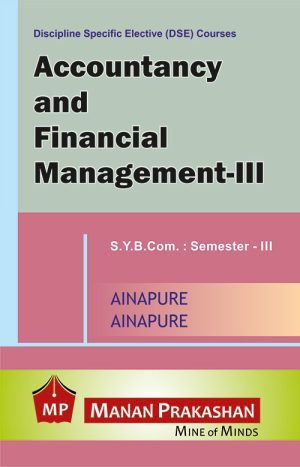Description
Financial Management – I
SYBBI Semester III
Syllabus
1. Introduction to Finance and Financial Management
A. Introduction to Finance
♦ Meaning and Definition of Finance
♦ Importance of Finance
♦ Types of Finance : Public and Private
♦ Sources of Finance
1. Long Term Sources : Term Loans, Debentures, Bonds, Zero Coupon Bonds, Convertible Bonds, Equity Shares, Preference Shares, CD, CP, Public Deposits
2. Short Term Sources : Bank Finance, Trade Credit, Other Short Term Sources
3. Venture Capital and Hybrid Financing
B. Financial Management
♦ Meaning and Importance of Financial Management
♦ Scope of Financial Management
♦ Functions and Objectives of Financial Management
♦ Primary Objective of Corporate Management
♦ Agency Problem
♦ Organisation of Finance Function
♦ Emerging Role of Finance Managers in India
C. Objectives of the Firm
♦ Profit Maximisation and Shareholders Wealth Maximisation
♦ Profit v/s Value Maximisation
2. Financial Goal Setting and Time Value of Money
A. Financial Goal Setting
♦ Introduction
♦ Financial Forecasting – Meaning, Techniques, Benefits
♦ Approaches to Financial Planning
♦ Economic Value Added (EVA) – Measurement and Components
♦ Free Cash Flow (FCF)
B. Time Value of Money
♦ Concept
♦ Present Value
♦ Annuity
♦ Techniques of Discounting
♦ Techniques of Compounding
3. Investment Decisions : Capital Budgeting
Capital Budgeting
♦ Nature of Capital Budgeting
♦ Purpose of Capital Budgeting
♦ Capital Budgeting Process
♦ Types of Capital Investment
♦ Basic Principle of Measuring Project Cash Flows
♦ Increment Principle, Long Term Funds Principle, Exclusion of Financial Cost Principle, Post Tax Principle
♦ Probability Technique for Measurement of Cash Flow
♦ Capital Budgeting Techniques : Net Present Value Profitability Index and Discounted Payback Method
♦ A Comparison; Project Selection Under Capital Rationing
(Note : Problems on Computation of Cash Flow, Ranking of Projects on Various Techniques, Selection and Analysis with / without Capital Rationing)
4. Financial Decisions
A. Cost of Capital
♦ Introduction and Definition of Cost of Capital
♦ Measurement of Cost of Capital
♦ Measurement of WACC using Book Value and Market Value Method
♦ Measuring Marginal Cost of Capital
B. Capital Structure Decisions
♦ Meaning and Choice of Capital Structure
♦ Importance of Optimal Capital Structure
♦ EBIT-EPS Analysis
♦ Capital Structure Theories
♦ Dividend Policies (Walter and Gordon)
Note : Relevant Law / Statute / Rules in force and relevant Accounting Standards in force on 1st April immediately preceding commencement of Academic Year is applicable for ensuing examination after relevant year.






Reviews
There are no reviews yet.